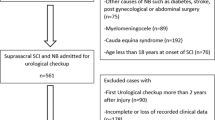Abstract
The aim of this study was to establish hazard ratios for the risk of complications of the upper urinary tract in relation to bladder management methods in patients with spinal cord injury. A total of 179 male patients were eligible for this investigation which was followed-up on a yearly basis until 2003. The average age at which the lesion occurred was 25.2 years (range 18–57). The average duration of follow-up since SCI was 29.3 years (range 10–53). During follow-up, the incidence of vesicoureteral reflux (VUR) was 15.1%. A total of 61 (34.1%) and 44 (24.6%) patients were diagnosed with pyelonephritis and renal stones, respectively. There were no significant differences in these complications among groups. Upper tract deterioration (UTD) was observed in 58 patients (32.4%). The incidence of UTD in the urethral catheter group (51.7%) was higher than that in other groups (P=0.008). Using multivariate analysis, patients with VUR were shown to have a higher risk of pyelonephritis (odds ratio 2.78; 95% confidence interval 1.16–6.68), and UTD (odds ratio 22.10; 95% confidence interval 6.92–70.56). We also found that UTD was more common for patients with an indwelling urethral catheter than for patients using other methods. For other variables, no positive association was observed. In cases which cannot undergo intermittent catheterization, or when the bladder cannot empty spontaneously, a suprapubic catheter is better than a urethral catheter for reducing UTD in this population. These findings suggest that even at a late stage post injury, bladder management methods are still important.
Similar content being viewed by others
References
Burke DC, Brown DJ, Burley HT, Ungar GH (1987) Data collection on spinal cord injuries: urological outcome. Paraplegia 25: 311
Borges PM, Hackler RH (1982) The urologic status of the Vietnam war paraplegic: a 15-year prospective follow-up. J Urol 127: 710
Jackson AB, DeVivo M (1992) Urological long-term follow-up in women with spinal cord injuries. Arch Phys Med Rehabil 73: 1029
Weld KJ, Dmochowski RR (2000) Effect of bladder management on urological complications in spinal cord injured patients. J Urol 163: 768
Drake MJ, Cortina-Borja M, Savic G, Charlifue SW, Gardner BP (2005) Prospective evaluation of urological effects of aging in chronic spinal cord injury by method of bladder management. Neurourol Urodyn 24: 111
Weld KJ, Wall BM, Mangold TA, Steere EL, Dmochowski RR (2000) Influences on renal function in chronic spinal cord injured patients. J Urol 164: 1490
Thomas DG, Lucas MG (1990) The urinary tract following spinal cord injury. In: Chisolm GD, Fair WR (eds) Scientific foundations of urology. Year Book Medical, Chicago, p 286
Chen Y, DeVivo MJ, Roseman JM (2000) Current trend and risk factors for kidney stones in persons with spinal cord injury: a longitudinal study. Spinal Cord 38: 346
Burr RG (1978) Urinary calculi composition in patients with spinal cord lesions. Arch Phys Med Rehabil 59: 84
Dewire DM, Owens RS, Anderson GA, Gottlieb MS, Lepor H (1992) A comparison of the urological complications associated with long-term management of quadriplegics with and without chronic indwelling urinary catheters. J Urol 147: 1069
Mitsui T, Minami K, Furuno T, Morita H, Koyanagi T (2000) Is suprapubic cystostomy an optimal urinary management in high quadriplegics? A comparative study of suprapubic cystostomy and clean intermittent catheterization. Eur Urol 38: 434
Hackler RH (1982) Long-term suprapubic cystostomy drainage in spinal cord injury patients. Br J Urol 54: 120
Larsen LD, Chamberlin DA, Khonsari F, Ahlering TE (1997) Retrospective analysis of urologic complications in male patients with spinal cord injury managed with and without indwelling urinary catheters. Urology 50: 418
The prevention and management of urinary tract infections among people with spinal cord injuries. National Institute on Disability and Rehabilitation Research Consensus Statement, January 27–29 1992. J Am Paraplegia Soc 15: 194
Author information
Authors and Affiliations
Corresponding author
Rights and permissions
About this article
Cite this article
Ku, J.H., Choi, W.J., Lee, K.Y. et al. Complications of the upper urinary tract in patients with spinal cord injury: a long-term follow-up study. Urol Res 33, 435–439 (2005). https://doi.org/10.1007/s00240-005-0504-4
Received:
Accepted:
Published:
Issue Date:
DOI: https://doi.org/10.1007/s00240-005-0504-4




